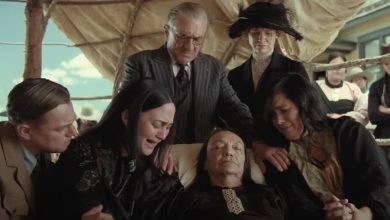Shutting the Door on the Hard-Knock Life

Getting to play Cinderella in a Broadway revival of “Into the Woods” sounds like a young musical theater performer’s dream, until you break your neck doing the pratfalls built into the role.
That’s what Laura Benanti says happened to her in 2002. “I was a 22-year-old girl who didn’t know how to say ‘this doesn’t feel safe to me,’” she wrote on her Instagram page nearly two decades later, after suffering “intense pain every single day for seven years,” two surgeries and much heartbreak.
At the time, people bad-mouthed her for missing performances.
Disastrous tumbles and physical danger are so much a part of theater history that they’ve become treasured backstage lore instead of causes for concern. I am ashamed to admit to laughing when I read about the dancer who fell into the “Anyone Can Whistle” orchestra pit in 1964, landing on a saxophone player, who promptly died. In 1991 we all gossiped merrily when the tempestuous Nicol Williamson ignored his fight choreography in “I Hate Hamlet” and struck his co-star Evan Handler with a sword. (Handler quit; Williamson got applause.) For much of the early 2010s, the mayhem of “Spider-Man: Turn Off the Dark” was an endless source of schadenfreude.

Laura Benanti as Cinderella in the 2002 Broadway revival of “Into the Woods.”Credit…Sara Krulwich/The New York Times
But concussions, broken ribs, a fractured skull, a crushed leg and an amputated foot — those are just the “Spider-Man” injuries — aren’t actually funny. And they are only the most visible part of the story of harm endured by theater workers onstage and off. In return for the privilege of scraping by in a field they love, they are commonly expected to endanger themselves physically and emotionally.
They dance till they drop. They work punishing hours. They strip themselves, often literally, and enact trauma over and over. If they are parents and nevertheless insist on sleeping more than five hours a night, they may see their children — as Amber Gray, a star in the original cast of “Hadestown,” told me — barely more than 50 minutes a day.
The pandemic put a temporary end to all that, reuniting families and helping injuries heal. The pause also gave theater workers, perhaps for the first time ever, plenty of time to consider the lives their profession requires them to lead. It’s no surprise that, as theaters reopened, calls for change therefore emerged with greater urgency. This summer I’ve been grappling with those demands, and in earlier parts of this series I’ve looked at ridding the art form of the “great man” inheritance that built cruelty into its DNA and the movement for fair pay.
But getting back to business has also reminded show people of the specific weirdness of their work. In sync with the resurgence of labor activism nationwide, actors, dancers, stage managers, technicians and others have been questioning the nuts and bolts of their contracts — both the documents that detail their jobs and the wider assumptions about what they owe an audience. Can the theater, they ask, find a way to uphold them more holistically as humans, even as they continue to gut themselves every night?
Some people will not even agree that it should. The idea that theater is a calling, not a job, and that the two categories are mutually exclusive, is so ingrained in the industry’s ethos — not to mention its business model — that demands for shorter working days, more understudies, intimacy coordinators, mental health stipends, child care reimbursements and other accommodations are often met with doubt or derision. Caring for actors, some say, is coddling. Suffering is a badge of honor, and the theater is properly a purple-heart club.
That indoctrination goes deep. Stanislavski saw his students as votaries in an ascetic cult. The men who created the dominant forms of American theater assembled their power by extorting it from others. Musicals have often romanticized the idea that a good artist is a starving one. And Broadway dancers, many trained in a system even more repressive than the theater’s, have traditionally been expected to perform like robots, retire early and shut up in between.
Perhaps the most pervasive and pernicious maxim is the one that says the show must go on — no matter what. Work rules that would seem ludicrous in any other business are, in the theater, built into the contracts. Performers represented by Actors’ Equity Association, the national labor union for actors and stage managers, are typically engaged for eight-show weeks, but productions can increase that number under certain circumstances. During holiday seasons, many offer 10-show schedules, and nonunion gigs can exceed even that.
Another rule, governing the number of hours a company can work during technical rehearsals, is so reviled it has been the subject of a 2015 backstage comedy. In Anne Washburn’s “10 out of 12” — named for the clause in Equity contracts that permits 12-hour days if there are two hours off — the under-slept and daylight-deprived company of an absurd plantation melodrama undergoes a kind of mass psychosis while the tech teams adjust lights and scenery.
It’s not fiction. Kate Shindle, the president of Equity, has lived it herself. As a working actor she spent part of 2018 at a regional theater having “an awesome creative experience,” she told me in an email. (She declined to name the theater.) “But the schedule was no joke. On the longest days, I left my apartment at 9 a.m. and didn’t return home until after 1 a.m. And to be clear, the employer wasn’t bending or breaking work rules. This is the intensity that the American theater has been relying on for generations. The workers have helped sustain a model that simply needs to be rewritten.”
At its annual convention last year, Equity delegates endorsed the elimination of 10 out of 12s — along with five-show weekend-performance schedules and six-day workweeks. But while these were just recommendations for future contract negotiations, some theaters have already begun to experiment with the ideas.
For Donya K. Washington, the festival producer at Oregon Shakespeare Festival, the experiment has its roots in 2016. It was then, while working at a different theater, that a production department head told her how the 12-hour tech calls for actors were nothing compared to what he experienced. To manage his crew, implement changes and debrief later, he arrived at the theater well before the cast and stayed well after. As a result, he was working 16-hour days for days at a time.
“That’s not sustainable,” Washington said in a recent Zoom conversation. “I didn’t know what to do about it, but it stuck in my head.”
After arriving in Oregon in 2019, where she was drafted onto the team creating the intensely complicated schedule that allows a repertory company to function, she started looking for ways to eliminate the 10 out of 12s. It was then that a worker “began proselytizing” for another quality-of-life improvement: the five-day workweek. “We had just finished building the calendar for the 2021 season, and my brain broke,” Washington said.
But the pandemic — which closed the festival’s theaters for 14 months — gave her time to think. Over the course of 50 calendar drafts, she played with the parameters. What if the company produced five shows instead of the usual 11? What if they mounted one show at a time instead of several in rep? In one of those passes, since the exercise “wasn’t real anyway,” she decided to see if “you could do a five-day, 40-hour week and still get a production up. And lo and behold you could.”
On a spreadsheet, anyway. In reality, when the festival fully reopened this April, the five-day week was not quite attainable. (They got as low as five-and-a-half.) But Washington feels it will be possible in the future, by adding about two additional weeks of rehearsals per show to make up for the lost time. The cost, she said, “would not be ginormous.” Already 10 out of 12s have been eliminated without trouble, reduced to 8 out of 10s — a step in the right direction. “And even if just from a business perspective it makes sense,” Washington added, because happier, healthier, better-rested companies produce a better product.
“Sometimes we have a mind-set of doing something for the sake of doing it, because that’s how it’s always been done,” she said. “But step by step we have to retrain ourselves. And not just actors. Even I have to remind myself I’m not supposed to work seven days a week!”
When I pointed out that we were having this conversation on a Sunday afternoon, Washington smiled and shrugged.
The theater is unlikely to become a model workplace anytime soon. It’s always going to be a very tough life choice for most people. But who gets to make that choice is one of the things at stake in the calls for bettering a work-life balance that more often presents itself as a work-nonwork nightmare. Those who can’t afford to be penniless must generally opt out of theatrical careers, and if they do get a job they can’t afford to complain.
Among that group, traditionally, have been parents of young children. Even if you have a stay-at-home partner or the means to hire full-time care, the mismatched hours of a baby’s schedule and an actor’s can be unbearable. Gray, the “Hadestown” star, was horrified to find that her older son, now 6, at some point started to cry whenever she sang, having learned to associate the sound with her going away. “It’s brutal,” she said, “when your child hates what you do. I felt like a deadbeat mom.”
Not that working while pregnant was less worrisome. “We sign contracts that say we must always be able to fit the costume,” she told me, adding that she hid her second pregnancy “because there are so many stigmas.”
But general acclaim for her performance in “Hadestown” — and a 2019 Tony Award nomination to cap it — emboldened her when her contract was up for renewal. “I asked for an alternate for the Sunday matinee and Tuesday night, so that I could be home at least one day when my kids are too.” Previously, like most actors, her only day off was a Monday.
When the producers, to her surprise, said yes, Gray found that the block of three days off, Sunday through Tuesday, made a huge difference. Finally getting enough sleep, she could “bang out” her two-show Wednesday “like nothing.” Her partner felt supported, she could play with her children, she could see other people’s work and attend the galas where connections are made. And even though the pandemic soon shut down that arrangement, it remains a model. Elizabeth Stanley, the star of “Jagged Little Pill,” made a similar deal when she returned to that show from maternity leave, splitting the role of Mary Jane with her friend Heidi Blickenstaff.
These are, so far, one-off solutions, available to women considered important to the commercial success of a show. To test whether the idea of supporting parents could work in the nonprofit sector, the Playwrights Realm, an Off Broadway company devoted to early-career playwrights, created a pilot program called the Radical Parent-Inclusion Project. Roberta Pereira, the Realm’s executive director, explained that during the 2019-20 season, which included a production of Anna Moench’s “Mothers,” the company basically tried every possible accommodation to make parents welcome not only onstage and backstage but also in the audience.
Among those accommodations was a caretaker reimbursement of up to $750, available to anyone working on the theater’s programming that season. (The credit was good for any kind of caretaking, including eldercare.) Rehearsals were cut back to 30 hours over the course of five days from 36 hours in six, necessitating an extra week to make up the difference. Broadway Babysitters, an arts-focused child care company, was hired to mind children during open auditions and callbacks, and a 4 p.m. matinee was added to the schedule. “For children who are younger and take naps,” Pereira said, “that was a much better time than 2 p.m.”
The free child care was not just for performers, by the way; audience members brought a total of 22 children, half of them less than a year old, to the matinee — which perhaps as a result sold out.
“Not that every theater should try this at the level we did,” Pereira said, “but you could see which things work for you. Some cost nothing, some cost a lot.” In all, the season’s caretaking enhancements added about $38,000 to the company’s $1.3 million budget, most of it covered by increased grants from its usual funders. That’s in line with what PAAL, the Parent Artist Advocacy League for Performing Arts and Media, has found at other theaters experimenting with child care programs. For Elevator Repair Service, a New York-based company, the cost of those programs amounted to less than 2 percent of the budget, PAAL reported.
As a result, Pereira said, actors who effectively used to pay to be in a show — or just to audition for it — may no longer have to make the choice between plays and parenting.
Achieving a better work-life balance is something you might expect to read about in emails from the human relations departments of companies promoting Yoga Thursdays. And though by no means common in American business, child care stipends are at least a familiar concept. But some of the other changes happening in the theater are intensely specific to the needs of the stage.
One is the growing presence of intimacy directors, who help shape moments of physical contact in ways that feel safe to the people performing them. Intimacy Directors & Choreographers, one of several organizations created to further the field, defines its aim as the creation of “a culture of consent” in storytelling. Though that culture was traditionally the responsibility of a show’s director, the history of abuse in rehearsal and production has led many actors to advocate for the hiring of dedicated professionals on every show where the subject may come up — which is to say, virtually all of them.
“To not have someone in that position is asking for trouble,” Audra McDonald told me in a recent phone interview. She first worked with an intimacy director in 2019, when Claire Warden helped stage the nude scenes and other physical interactions between her and her co-star, Michael Shannon, in “Frankie and Johnny in the Clair de Lune.” Having been in previous situations where she felt she “didn’t have the right to speak up about what was happening,” McDonald found Warden’s presence “revelatory.”
“Knowing what the boundaries and parameters were for what Michael and I had to go through on that stage, we could push up against them as hard as we possibly could while knowing what lines not to cross,” she said. “It’s about knowing where the bottom of the pool is, so you feel safer about diving all the way down and then swimming as fearlessly and fiercely as you want.”
“Pass Over,” Antoinette Chinonye Nwandu’s harrowing play about the precarious lives of two young Black men, also had an intimacy coordinator, Ann James. But its producers offered the cast another protection against the potential trauma of the story: a mental health allowance.
The allowance permitted actors to seek reimbursements of up to $250 a week for expenses deemed beneficial to their “health and wellness as it relates to performing this show eight times a week,” the policy stated. Matt Ross, the lead producer, added that the definition of “health and wellness” was deliberately broad; it could mean, for instance, a therapist or a voice lesson or a massage.
Cody Renard Richard, the production stage manager, said it was only fitting to offer that support. “From their first class, actors have been asked to bring their traumas into a certain space, been nagged to call up personal stuff so they can cry in a scene. To ask them to open their wounds like that and not give them the help to deal with the result is incredibly unfair.”
The additional cost of the mental health stipend, along with the production’s intimacy coordinator and the equity, diversity and inclusion consultant, Nicole Johnson, was “minuscule,” Ross said. “Probably less than 1 percent of the overall weekly costs.”
But low cost is not the main selling point for advocates of such changes; undoing the harm built into the system is. And one of the reasons there is so much resistance to what seem like obviously worthy goals is that the harm has never been evenly distributed. When I spoke to Wayne Cilento, who originated the song “I Can Do That” in the 1975 musical “A Chorus Line,” he seemed proud of his ability to work on that show despite what he described as constant back and knee injuries. Later, in Bob Fosse’s “Dancin’,” which earned Cilento a Tony Award nomination in 1978, he missed only two performances in one-and-a-half years “while other people who didn’t have my urgency were dropping all around,” he said. “Stepping out was not my way.”
Still, in preparing to direct and choreograph a revival of “Dancin’” for Broadway, he said he was more conscious of looking out for his dancers than Fosse was. (Fosse “never had a conversation about how’s your back or how’s your hamstring.”) For the tryout at San Diego’s Old Globe this spring, he cut the material from three acts to two and divvied up “his” track — the sequence of dances he’d done in the original production — among several men because it now seemed too much to ask of just one. For the planned 2023 Broadway production, he is rethinking the number of swings and covers to step into any role at any time so that injured dancers will feel less pressure to perform. And he is much more collaborative with the ensemble than Fosse was with him.
“But it’s a fine line,” he said. “Incorporating the ensemble in the conversation makes them feel trusted and cared for, and it’s good for the show. But — this sounds awful — even though I want to hear your problems, at some point I don’t want to. The bottom line is: What you have to do for the show is what you have to do for the show. And the director, the choreographer, is the one who decides what that is.”
Cilento is touching on a problem that underlies the uneasiness some people feel about the changes advocates are seeking. So much of what we are used to in the theater, so much of it thrilling, is ultimately the result of individual virtuosity being inspired by individual vision, even if the individual with the vision is a tyrant. When everyone is equally empowered what happens to it? If the theater ever does become a worker’s paradise, will it still produce heavenly art?
Another source of unease is that those of us — I include myself — who grew up in the harsh, sometimes inhumane ways of thinking about the theater may have developed a kind of Stockholm syndrome. About the harshness we are blasé or even sentimental. When, in “A Chorus Line,” Cilento sang, with the rest of the ensemble, “What I Did for Love,” we understood the response to be: Everything. Anything. The gift was ours to borrow.
Now I’m pretty sure that’s not the right answer.




